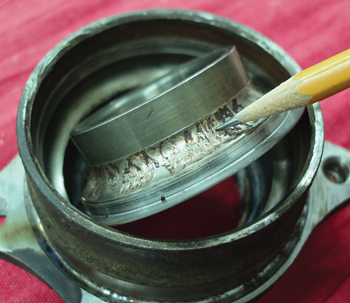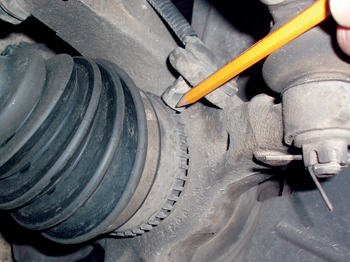ot is a lubricant “spray” collecting on the chassis surfaces surrounding the joint. When the lubricant is completely gone, the joint will wear out and eventually separate. The most common symptom of worn CV joints is the clicking noise that characteristically occurs when the vehicle is driven through a short right- or left-hand turning radius under power. On rare occasion, a CV joint will seize, which causes a wobbling sensation in the steering wheel. A potential catastrophic failure might be indicated when the transmission engagement between drive and reverse is accompanied by a clanking or knocking noise.
Several basic rules should cover CV half-shaft installations. First, make it a habit to remove only one shaft at a time because there still are a few vehicles in which the differential carrier can drop to the bottom of the gear case when both axles are removed at the same time. Next, avoid mixing the right -and left-hand shafts because some minor differences might exist between their compression or extension lengths. Because using an impact wrench can damage the joint or adversely affect wheel bearing preload, always use a torque wrench to tighten the CV axle retaining nut to specification.
Hubs and Bearings
Because tapered-roller front wheel bearings require frequent lubrication and adjustments, permanently preloaded and lubricated bearing hub assemblies have generally replaced them. Correct preloading is required in modern wheel bearing assemblies because the clearance between wheel speed sensors and tone rings is critical. Preloaded bearings also reduce the rotating friction of the disc brake assemblies by helping maintain a small, but significant, air gap between the brake rotor and pads.
Since this wheel bearing had plenty of lubricant, it’s safe to assume that the failure was caused by a metallurgical problem.
When diagnosing any wheel bearing noise, it’s important to remember that modern wheel bearings must 1) support the vertical load created by the vehicle’s weight, 2) withstand the forward thrust of the driving wheels, and 3) resist lateral loading during cornering. Any noise coming from the wheel bearings will, therefore, be most often duplicated under one or more of these driving conditions.
See Photo 4.
When road-testing the vehicle to duplicate an NVH complaint, notice that wheel bearing and drivetrain noises are constant, whereas tire noises vary according to the road surface. If a vacant parking lot is available, weave the vehicle back and forth at low speed to alternately load and unload the wheel bearings. Notice also if the noise level changes as the vehicle stops and accelerates. After the wheel bearings have warmed up after an extended drive, check each bearing hub’s temperature with an infrared heat gun. In most cases, the defective wheel bearing will indicate a higher operating temperature.
Worn wheel bearings can cause clearance problems at the ABS sensor and store ABS trouble codes.
Last, raise the vehicle with the wheels suspended. Grasp each tire at the 12:00 and 6:00 o’clock positions to check for looseness caused by a loss of preload in the bearings. Looseness in the wheel bearings might also cause a wheel speed sensor trouble code to be stored in the vehicle’s ABS module. If the vehicle comes in with the ABS light illuminated and a wheel speed code stored, check that wheel for worn bearings.
See Photo 5.
When replacing bearing hub assemblies fitted into aluminum control arms, try heating the control arm with an electric paint removal gun. In most cases, the aluminum will expand enough to expedite removal of the hub assembly. Expedite installation by thoroughly cleaning and lubricating the hub’s mounting surfaces. Replace all retaining bolts as required, apply lubricant or threadlocking compound as directed and torque each to the manufacturer’s specification.













